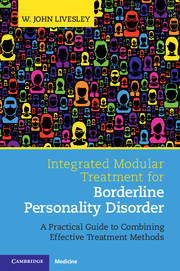 Integrated Modular Treatment for Borderline Personality Disorder
Integrated Modular Treatment for Borderline Personality Disorder Book contents
- Frontmatter
- Dedication
- Contents
- Preface
- Section 1 Introduction and Framework for Understanding Borderline Personality Disorder
- Section 2 Assessment and Treatment Planning
- 5 Diagnosis and Assessment
- 6 Formulation, Treatment Planning, and the Treatment Contract
- Section 3 General Treatment Modules
- Section 4 Safety, Containment, and Engagement: The Initial Phase of Treatment
- Section 5 Improving Emotional Regulation and Modulation
- Section 6 Exploration and Change: Treating Interpersonal Problems
- Section 7 Constructing an Adaptive Sense of Self
- Section 8 Retrospect and Prospect
- References
- Index
6 - Formulation, Treatment Planning, and the Treatment Contract
from Section 2 - Assessment and Treatment Planning
Published online by Cambridge University Press: 16 February 2017
- Frontmatter
- Dedication
- Contents
- Preface
- Section 1 Introduction and Framework for Understanding Borderline Personality Disorder
- Section 2 Assessment and Treatment Planning
- 5 Diagnosis and Assessment
- 6 Formulation, Treatment Planning, and the Treatment Contract
- Section 3 General Treatment Modules
- Section 4 Safety, Containment, and Engagement: The Initial Phase of Treatment
- Section 5 Improving Emotional Regulation and Modulation
- Section 6 Exploration and Change: Treating Interpersonal Problems
- Section 7 Constructing an Adaptive Sense of Self
- Section 8 Retrospect and Prospect
- References
- Index
Summary
The end point of diagnostic assessment is a formulation of the patient's problems. This chapter discusses structure of the case formulation in integrated modular treatment (IMT) and its use in planning treatment and establishing the treatment contract.
Formulation
Formulations are narrative accounts of how diverse biological, psychological, social, and cultural influences coalesce to create a patient's current condition, which provide therapists with a road map for treatment and patients with an explanation of the nature and origins of their problems. This requires formulations to be expressed in clear, jargon-free, non-technical, “near-experience” language based on the patient's own language whenever possible.
Contents
Effective formulations have descriptive and prescriptive components. The descriptive component describes the origins, precipitants, and factors that perpetuate problems. The prescriptive element specifies initial treatment goals, treatment intensity, expected course of treatment, and potential obstacles. However, a formulation does not simply list important facts; it shapes this information into a narrative that welds together key factors and draws attention to salient issues.
Formulations typically include (i) an account of presenting problems including symptoms, current concerns, and contemporary situational factors (social, financial, legal, and occupational) along with a brief history of these problems; (ii) a discussion of vulnerability factors, including genetic predisposition, other co-occurring mental disorders, psychosocial influences, and any medical conditions; (iii) a developmental history organized around critical events and relationships; (iv) a description of personality; (v) a broad understanding of how personality factors and life events interacted to create and perpetuate current problems; and (vi) diagnostic information about borderline personality disorder (BPD) and other mental disorders. The formulation should also identify targets for change. This is readily achieved by organizing problems into the four domains (symptoms, regulation and modulation, interpersonal, and self/identity) described earlier. This leads naturally to the prescriptive aspects of the formulation because domains are closely tied to specific treatment modules and the sequence in which problems are addressed.
- Type
- Chapter
- Information
- Integrated Modular Treatment for Borderline Personality DisorderA Practical Guide to Combining Effective Treatment Methods, pp. 66 - 78Publisher: Cambridge University PressPrint publication year: 2017


